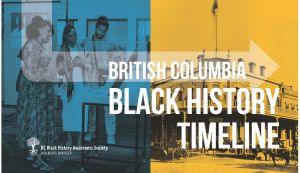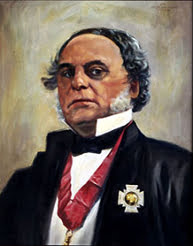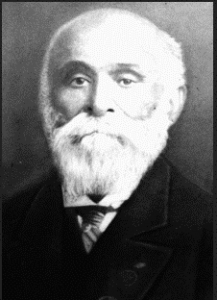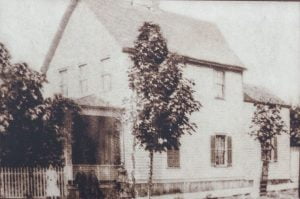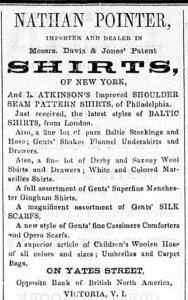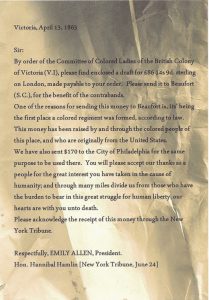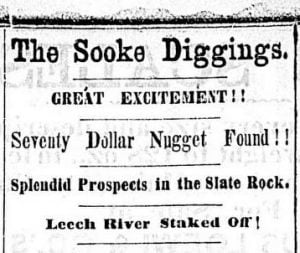BC Black History Timeline
Some events occurred on a specific date and others took place over a period of time.
Timelines can …
- Connect individual events and people and their relation to an era as a whole
- Demonstrate the overlapping or concurrency of seemingly unrelated events
- Highlight patterns played out in history
- Identify cause and effect relationships surrounding historical events
- Improve recollection of events, people and places and their relationship to each other
The Slavery Abolition Act, passed by the British Parliament in 1833, came into force on August 1, 1834.
In fact, the Act liberated less than 50 enslaved Africans in British North America. For most enslaved people in Canada, the Act resulted only in partial liberation, only emancipated children under the age of six, and obliged others to be retained for four to six years as apprentices. The Act did initiate the formal end to slavery, and since 2021 Emancipation Day has been commemorated annually in Canada on August 1. Emancipation Day in Canada: Past, Present, and Future
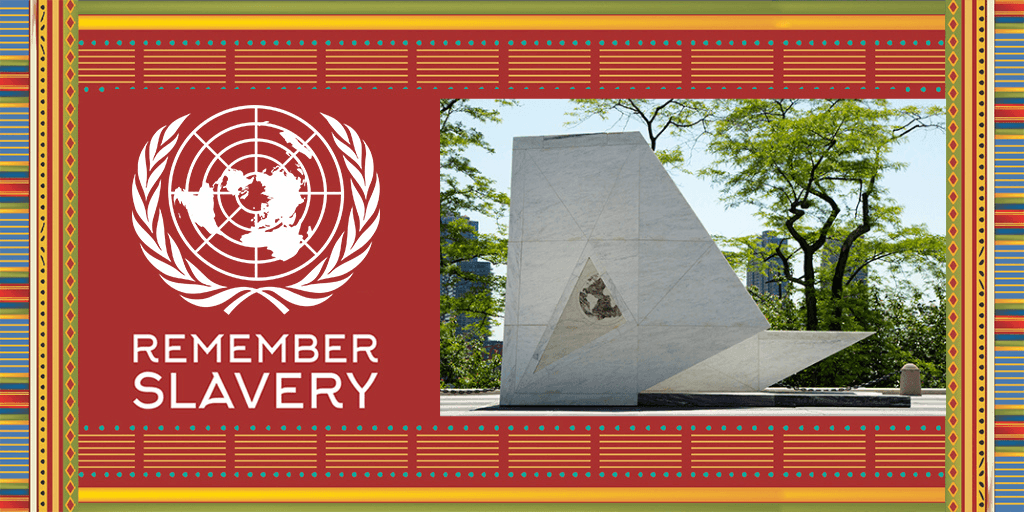
Emancipation and abolition of slavery became law in the U.S. through the 13th Amendment to the Constitution after it was ratified by 2/3 of the states on December 6, 1865.
The Imperial Government of the Crown Colony of Vancouver Island was created on March 11, 1850. Richard Blanshard, a 32 year-old barrister from a wealthy British family, formally assumed office as Governor of the Colony of Vancouver Island.
James Douglas was born in Guyana in 1803. His father was Scottish and his mother was “free coloured.” Douglas was Chief Factor for the Hudson’s Bay Company operating from Fort Victoria. In 1851 he was appointed Governor of the Crown Colony of Vancouver Island, succeeding Richard Blanshard. Meanwhile, the mainland colony functioned under the defacto administration of the Hudson’s Bay Company with Douglas as its chief executive. In 1858, the mainland colony became the Colony of British Columbia, and Douglas was named as its governor. He concurrently continued as Governor of Vancouver Island, which remained a separate colony until 1866. Queen Victoria knighted Douglas in 1863. Read more
Here are the dates and places of important gold finds in BC. The 1858 Fraser River Gold Rush, 1859 Cariboo Gold Rush and the 1864 Leech River Gold Rush are the most significant in BC Black history.
1851 Haida Gwaii Gold Rush
1858 Fraser River Gold Rush*
1859 Cariboo Gold Rush*
1864 Leech River (Vancouver Island) Gold Rush*
1865 Big Bend Gold Rush
1873 Cassiar Gold Rush
1885 Granite Creek Gold Rush
1898 Atlin Gold Rush
On April 14, 1858, as the Black community were celebrating the release of fugitive slave Archy Lee at the African Methodist Episcopal Zion Church in San Francisco, Jeremiah Nagle, captain of the steamship Commodore, arrived at the meeting. It is reported that Nagle came well-prepared to the meeting with maps of Vancouver Island and a letter from “a gentleman in the service of the Hudson’s Bay Company of undoubted veracity” inviting the Black community to come to the Colony of Vancouver Island and giving details about the colony. The Pioneer Committee arrived in Victoria on April 25, 1858.
On April 25th,1858 the Steamship Commodore sailed into Victoria harbour from San Francisco. In addition to 450 gold seekers, 35 Black people were on board – the Pioneer Committee to consult with Governor Douglas. A delegation of three that met with Douglas: Fortune Richard, Wellington Delaney Moses and Mr. Mercier.
This plaque installed at the harbour by the City of Victoria on August 18, 1978 reads, “In commemoration of the arrival in 1858 of the first group of Black settlers to the Colony of Vancouver Island.”
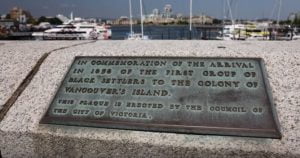
The Colony of British Columbia, named by Queen Victoria, with New Westminster as its capital, is the area today known as “the mainland”. It was a separate entity from the Colony of Vancouver Island. Accounts relate that James Douglas agreed to sever his ties to the Hudson’s Bay Company to become governor of both the Colony of Vancouver Island and the Colony of British Columbia.
In September 1858, the Victoria Gazette reported on the application of 52 Black men for British citizenship. Their occupations were Baker, Barber, Blacksmith, Carman, Carpenter, Carrier, Contractor, Cook, Cooper, Drayman, Farmer, Fruiterer, Gardener, Grocer, Hairdresser, Laundryman, Merchant, Messenger, Miner, Painter, Plasterer, Porter, Restaurant keeper, Saloon keeper, Ships carpenter, Ships caulker, Storekeeper, Tailor, Teamster, and Water carrier.
Pre-emption was the legal method of acquiring Crown land that had not been fully surveyed by claiming and improving it for settlement and agricultural purposes. The first Black pre-empters on Salt Spring from California arrived in the summer of 1859. They included E.A. Booth, Armstead Buckner, William Isaacs, and Fielding Spotts. Black settlers later in that same year included Abraham Copeland, Levi Davis, W.L. Harrison, the Jones brothers (John Craven, William Allen, and Elias), William Robinson, and Hiram Whims. Daniel Fredison, a Black man from Hawaii, also settled on the island.
Salt Spring Island Archives has mapped 26 Black homesteads
John Craven Jones graduated from Oberlin College in 1856 and taught for two years in a one-room school for Black students in Xenia, Ohio. When he moved to Salt Spring Island in 1859, he pre-empted 100 acres for his home; and with the support of the community, he resumed teaching. John taught a total of 25 students in two schools until about 1875, one in Vesuvius and one in Fernwood. The first schools were in rough buildings, hardly more than sheds. In 1869 when public funding began, Jones’ salary was $40.00 per month. Read more
The Daily Colonist reported on a “difference of opinion” between Rev. W.F. Clarke and Rev. M. MacFie, both missionaries sent to Victoria from England by the Congregational Missionary Society, “Mr. Clark holds that Christianity knows no difference between the white and colored man; and therefore he will not suit the prejudices of anyone by creating a ‘negro’s corner’ in his church. As a matter of ‘taste’ Mr. MacFie prefers separating them.”
- The Colonial Missionary Society settled the issue on August 14,1860 by passing a resolution holding, “That this committee never have sanctioned and never will sanction in Churches wholly or in part sustained by the funds of the Colonial Missionary Society, the compulsory separation, in places of worship, of the colored races from the white population.”
By the spring of 1860, 40 to 50 Black men had enrolled in the Victoria Pioneer Rifle Corps and in July 1861 were officially sworn in. The Royal Navy supplied drill sergeants and the Corps financed and built a drill house. The Victoria Pioneer Rifle Corps is considered the first British or Canadian military unit formed west of Ontario.
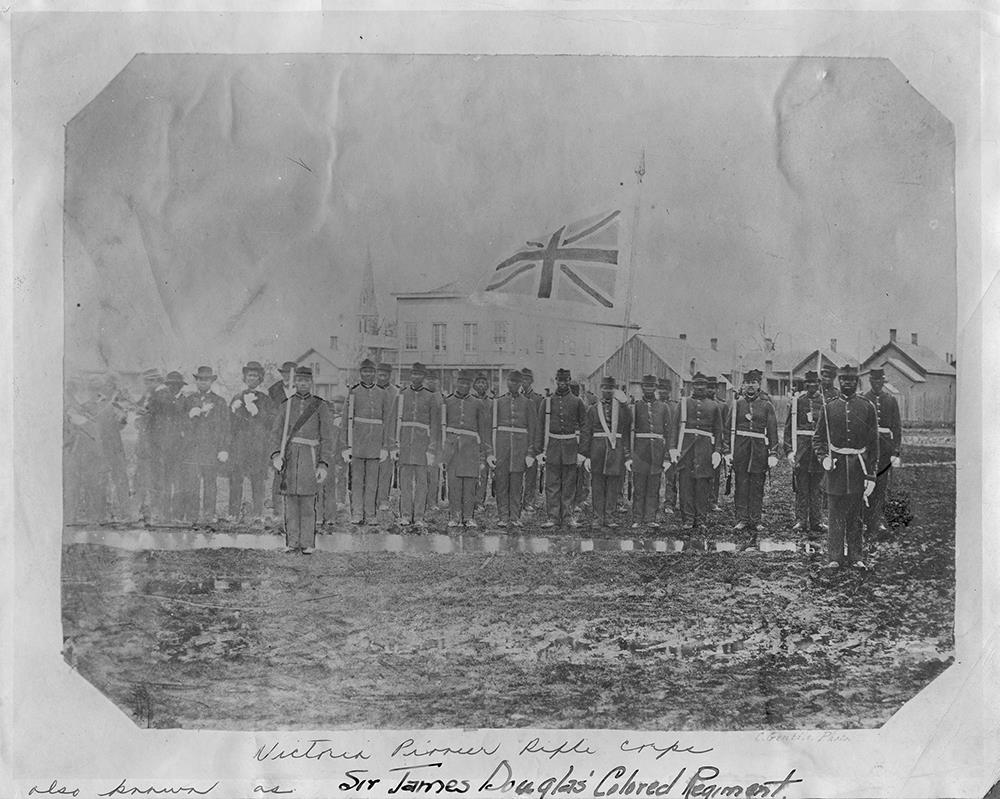
The “First Victoria Directory” was originally published in March 1860. It is “comprised of a general directory of citizens, also, an Officials list, list of voters, postal arrangements and notices of trades and professions; preceded by a preface and synopsis of the commercial progress of the colonies of Vancouver Island and British Columbia. Illustrated”
From the recognized names, an estimated 27 Black men were listed as citizens. Moses Rowe Smith, who immigrated to Victoria from Ontario, appears to be the only Black man on the list of voters.
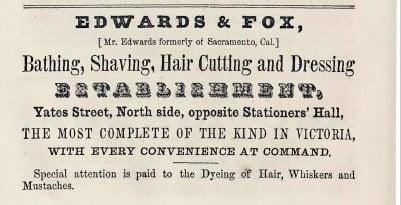
Charles Mitchell, enslaved since boyhood, was a stowaway aboard the SS Eliza Anderson sailing from Olympia Washington to Victoria. When the steamer arrived in Victoria word soon spread that a slave was being detained on board. The Royal BC Museum and Archives documented that “As many as 700 people gathered dockside on September 25th, 1860 calling for his release.” The case was taken immediately to the BC Supreme Court where Charles Mitchell was declared a free man because he was on British soil.
Watch the video produced by the Royal BC Museum in a series “This Week in History: Charles Mitchell, from slavery to freedom.
On April 12, 1861 President Abraham Lincoln declared war between the Union and Confederate states. An estimated four million enslaved people in 15 states and territories were “owned” by 52,128 slaveholders. There were also an estimated 400,000 free African Americans. The war is considered to have ended on April 9, 1865, when Confederate General Robert E. Lee surrendered to Union General Ulysses S. Grant.
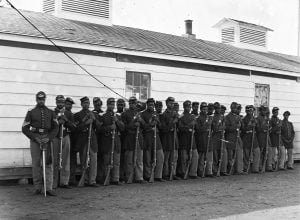
While reported incidents of discrimination in Victoria’s theatres date back to 1860, the most noted incident happened on September 25, 1861 when Mifflin and Maria Gibbs, family friend Nathan Pointer and Pointer’s daughter attended a hospital benefit at the Victoria Theatre. Both families were seated in the dress circle.
At the start of the concert one of the performers, Emil Sutro, refused to go on stage unless the Black patrons were removed from the dress circle. Gibbs refused to move, Sutro left, and the concert went ahead. Then, at the end of the performance the Gibbs and Pointers were doused with flour from the balcony.
A melee broke out and charges were filed against all involved. At the trial the judge acquitted the four white persons charged in the incident. Gibbs admitted assaulting one man and was fined five pounds. The charge of assault against Nathan Pointer was dropped for lack of evidence.
Theatres began publicly stating Black patrons could only be seated in the gallery. The newspapers received numerous letters both supporting and condemning the Black community. Black residents petitioned both Douglas and his successor on Vancouver Island, Arthur Kennedy to end the discrimination, but no remedy was made.
Four candidates contended for two vacant Legislative Assembly seats in Victoria in an 1861 by-election.
Joseph Trutch came in second in voting and Jacob Francis was third. There was public debate and support for Francis’s claim to the seat, in that Trutch was absent from the colony when the election was called and could not take the required oath of allegiance. Francis’s petition failed, and Trutch’s election stood.
John and Charlotte Dandridge arrived in Victoria in 1858. John was one of the men who applied for citizenship in 1858. In 1860 they were joined by their daughter Sydna, her husband Abner Hunt Francis and their grand-daughter Theodosia, age about 16. The house was built with most of the financing from Abner. It’s original location was on Johnson Street; and it was moved to Rudlin Street around 1897-98. Following a major restoration project, the home received heritage designation in 2003.
More about “The House That John Built” and what the current owners have to say.
Image: Dandrige House, circa 1872, courtesy of current owners
Jacob Francis fought discrimination by suing two bar owners for refusing to serve him. While he was not successful against the first barkeeper in April 1860, in July 1862 he achieved a favorable outcome against the second barkeeper. The magistrate ruled that any barkeeper refusing service to Black men would not be given a license or would be find five pounds sterling and their licence would not be renewed.
In the fall of 1862 John Robert Giscome and Henry McDame embarked on their one year, 60 km trek to explore northern BC and northern parts of what is today the provinces of Alberta and Saskatchewan. As early as 1874 one of the creeks they discovered became known as McDame Creek. This name was officially adopted in the First Report of the Geographic Board of Canada, 1898, as a well-established local name.
The Giscome Portage Trail, designated as an official Heritage Site on July 17, 1997, commemorates their trek. The Indigenous name of the trail is Lhdesti or “the shortcut” and was long used by the Lheidli T’enneh First Nations as one of their trade routes.
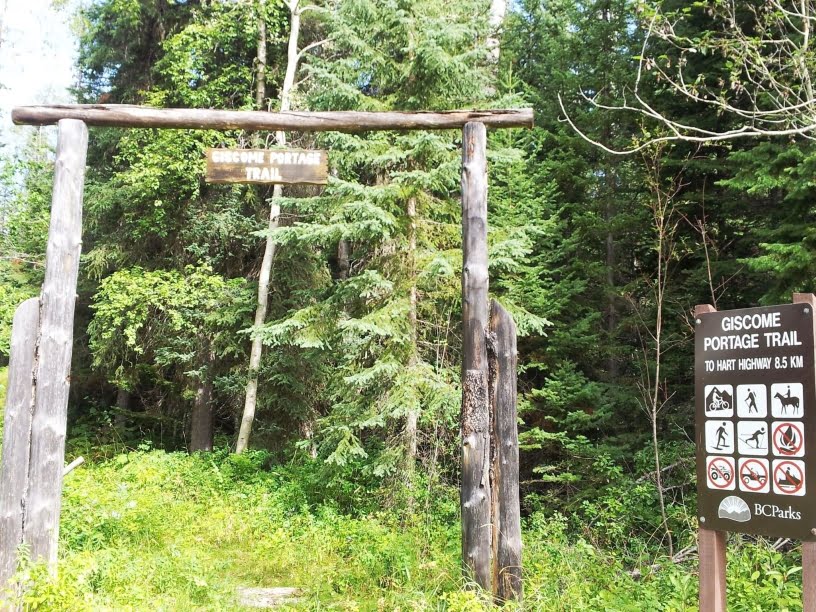
Image Courtesy of Kevin Creamore, Prince George
The Emancipation Proclamation issued by U.S. President Abraham Lincoln the previous September came into effect on January 1,1863. However it did not abolish slavery. The Proclamation declared free all enslaved people in the Confederate States who resided in territory still in rebellion against the United States. As the Union Army captured more Confederate territory it would also liberate enslaved people living in that territory. Emancipation and abolition of slavery only became law in the U.S. through the 13th Amendment to the Constitution after it was ratified by 2/3 of the states on December 6, 1865.
The Government Gazette lists “Persons liable to pay taxes under the provision of the ‘Trade Licenses Amendment Act, 1862’ for the half-year commencing July 1, 1863.” 22 Black businesses have been recognized as included in the listing. Thomas Whiting Pierre’s tailoring business was assessed $300. His son John Thomas Pierre took over the business circa 1890 when he was 27. Nathan Pointer’s clothing store had the highest assessment of the Black businesses at $2,600.00.
Entrepreneurs, businesses, shops, and services
The Black soldiers who supported the Union in the American Civil War were known as “the Contrabands.” The Fugitive Slave Act, which deemed people held as slaves as “property” to be returned to their owners, had been the law in effect prior to the commencement of the Civil War. The Confiscation Act of 1861 was passed in the U.S. to overrule the former law. The Confiscation Act was effectively used to ensure that Black soldiers fighting on the side of the northern army would not be returned to slave holders. The letter from the Committee expressed that “..though many miles divide us from those who have the burden to bear in this great struggle for human liberty, our hearts are with you unto death.”
In the summer of 1864, four Black men, Samuel Booth, George Munro, John Tyril and William Dyer discovered gold on the Leech River in Sooke, about 40 miles west of Victoria. On August 4, 1864 the local newspaper reported on the high purity of the specimen found. It was worth $73.20 (about $2,500.00 in 2020 Canadian dollars). The four men formed the Industry Company. Unlike the distant Fraser and Caribou gold finds, prospectors could travel from Victoria overland by trail or by steamer within a day. Stores, hotels and other mining-related businesses were quickly established but within 18 months were abandoned.

